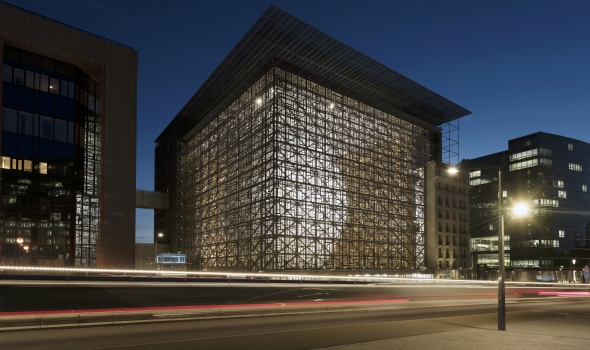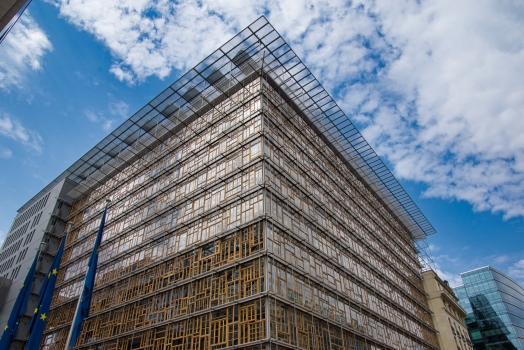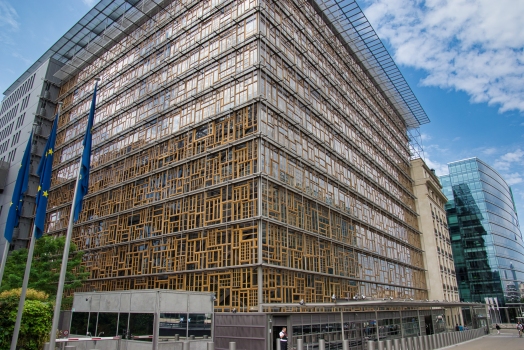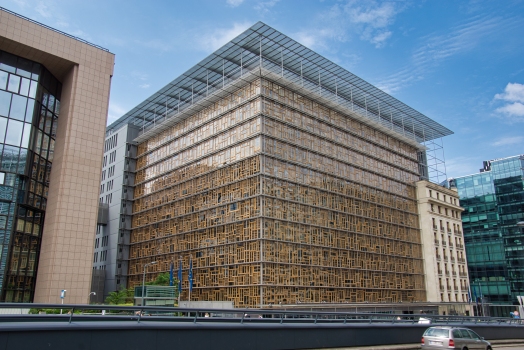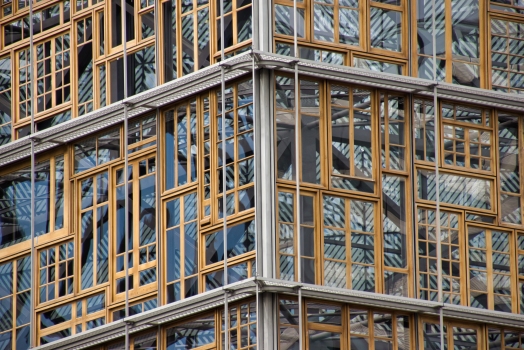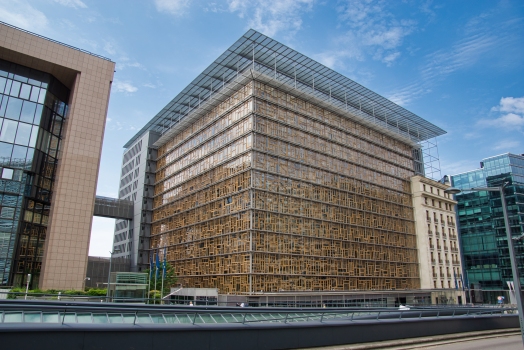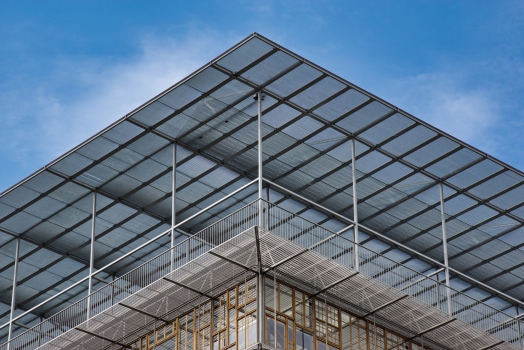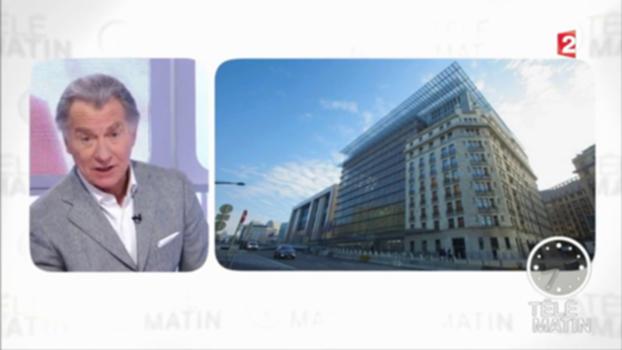General Information
| Other name(s): | Résidence Palace |
|---|---|
| Beginning of works: | January 2008 |
| Completion: | January 2017 |
| Status: | in use |
Project Type
| Function / usage: |
Public administration building |
|---|---|
| Architectural style: |
Postmodern |
Location
| Location: |
Brussels, Brussels-Capital, Belgium |
|---|---|
| Address: | Rue de la Loi / Wetstraat 155 |
| Coordinates: | 50° 50' 33" N 4° 22' 50.99" E |
Technical Information
Dimensions
| office space | 27 163 m² | |
| gross floor area | 53 815 m² | |
| number of parking spaces | 145 |
Architecture
As a consequence of 2004 European enlargement, the Justus Lipsius building became too small for the Council of the European Union to use. According to the treaty of Nice, adopted in 2001, all European Council sessions are to be held in Brussels, which results in corresponding needs for meeting and office space. In order to respond to those, the Belgian State offered the Council to cede block A of the "Residence Palace" complex to convert it to become the future seat of both the European Council and the Council of the European Union.
The existing building thus needed to be reconfigured to cater for quarterly meetings of the European Council and biweekly sessions of the Council of the European Union, as well as offices for the President of the latter as well as the Secretary-General, delegate offices for the various member states and facilities for the press.
In August 2004, the Council of the European Union and the Belgian Building Agency launched a design competition that selected 25 design teams on 25 January 2005. Out of a final round of 6, the winner of the competition was announced on 2 September 2005 as Philippe Samyn and Partners with Studio Valle Progettazioni and Buro Happold.
The original Art Deco building, the Residence Palace, was built from 1922 and 1927 at the behest of financier Lucien Kasin and designed by Swiss architect Michel Polak. The complex was a collective housing experiment consisting of serviced luxury flats located near the city center. The commercial success was short-lived and the building was converted into ministerial offices after World War II by the Belgian state.
In the 1960s, an extension with a new façade was built behind the original structure. In the 1980s the eastern wing was demolished to make way for the Justus Lipsius building, the previous seat of the Council.
The urban planning guidelines specified that the building is converted from an "L" shape to a cube. The shape of this volume follows the minimal required surface for each type of room, as for example the press room (level +1), the smallest 50-persons dining room (level +11), the largest meeting room enabling 250 persons meetings (level +5), other meeting rooms (level +3, +7) and finally the largest dining room for official dinners (level +9). Each level of this volume has an elliptic plan with different dimensions but the same center and the same principal axis. The structure of this object is rigorously symmetrical although it does not appear so.
The new double facade, made of a harmonized patchwork of re-used old oak windows with simple crystal like single glazing (from the different European countries) provides the necessary acoustic barrier from the traffic noise of the Rue de la Loi - Wetstraat and it also offers a first thermal insulation for the inner space. Indeed, following to UE recommendations about energy savings, many old buildings across Europe will change their window frames for double glazing in the next few years. In the context of a sustainable development approach, it was decided to restore some of those millions of old though still efficient window frames, and re-use them in this project. This new façade is both a practical and philosophical statement about the re-use of these traditional constructions elements, expressing the European diversity of cultures.
Moreover, the council wished this building to be from all points of view an example as far as sustainable development is concerned. This wish is displayed in many aspects of the architectural and technical design. As an example, an umbrella of photovoltaic panels for the electricity production covers both the new and the historical parts, which symbolizes also the link between the present, the past and the future.
Excerpt from Wikipedia
The Europa building is the seat of the European Council and Council of the European Union, located on Wetstraat/Rue de la Loi in the European Quarter of Brussels, the capital city of Belgium. Its defining feature is the multi-storey "lantern-shaped" construct holding the main meeting rooms; a representation of which has been adopted by both the European Council and Council of the EU as their official emblems. The Europa building is situated on the former site of the partially demolished and renovated Bloc A of the Résidence Palace. Its exterior combines the listed Art Deco façade of the original 1920s building with the contemporary design of architect Philippe Samyn. The building is linked via two skyways and a service tunnel to the adjacent Justus Lipsius building, which provides for additional office space, meeting rooms and press facilities.
History
Construction and former usage: the Résidence Palace
Following the end of the First World War, Walloon businessman Lucien Kaisin, in collaboration with Swiss architect, Michel Polak, put forward plans for a complex of luxurious apartment blocks for the bourgeoisie and aristocracy, the Résidence Palace, to be situated on the edge of Brussels' Leopold Quarter. Consisting of five Blocs (A - E), it was to be "a small town within a city" able to provide its residents with onsite facilities, including a theatre hall, a swimming pool, as well as other commercial services such as a restaurants and hairdressers. The Résidence Palace aimed to address the dual shortage of suitable property and domestic workers for the upper classes following the destruction brought about during the war. The foundation stone of the Art Deco building was laid on 30 May 1923 with the first residents moving in 1927.
The development, however, only had a short commercial success. In 1940 tenants were forced to leave, as the building was requisitioned as the headquarters of the occupying German army during the Nazi occupation of Belgium during the Second World War. In September 1944, after the liberation of Brussels, the building was taken over as headquarters for SHAEF and RAF Second Tactical Air Force.
After the War, in 1947, the Belgian government bought the complex and used Bloc A (the north-east L-shaped building) for administrative offices. At the end of the 1960s, as part of work to modernise the area during the construction of an underground railway line beneath Rue de la Loi, a new aluminium façade was built, closing the L-shape, under the supervision of Michel Polak's sons.
Development of the European Quarter
With the development of the European Quarter in Brussels, city planners struggled to find suitable office space to house the growing staff and needs of the European Union institutions situated in close proximity to the Résidence Palace. In 1988, the eastern part of the Résidence Palace, BlocsD and E were demolished to make way for the construction of the Justus Lipsius building as the seat of the Council of the European Union. In 2002, the European Council, the organisation gathering the EU's Heads of State/Government together, also began using the Justus Lipsius building as their Brussels venue. This followed an advanced implementation of a decision by European leaders during ratification of the Nice Treaty to do so at such a time as the total membership of the European Union surpassed 18 member states. Prior to this, the venue for European Council summits was in the member state that held the rotating Presidency of the Council of the European Union. The resulting growing international media presence in the area led the Belgian Federal Government to develop Blocs C and B as the site of its new International Press Centre. A swimming pool and theatre were also maintained.
However, in 2004 leaders decided the logistical problems created by the outdated facilities warranted the construction of a new purpose built seat able to cope with the nearly 6,000 meetings, working groups, and summits per year. This being despite a number of renovations to the Justus Lipsius building, including the conversion of an underground carpark into additional meeting rooms. The Belgian government proposed as a solution the conversion of Bloc A of the Résidence Palace into a new permanent seat for both EU institutions. Under the deal, the site would be transferred from the Belgian government to the Council's Secretariat for the symbolic price of €1, with the Council assuming the costs for the subsequent construction project.
Transformation of Bloc A into the Europa building
A pan-European competition was opened to redesign Bloc A of the Résidence Palace to suit the needs of the institutions. As the original Art Deco façades of the Résidence Palace building were listed as historic monuments, competition rules stated that these had to be retained. In 2005, it was announced that a team involving Belgian architect Philippe Samyn and Partners (architects and engineers), lead and design partner, in collaboration with Studio Valle Progettazioni (architects), and Buro Happold (engineers) had succeeded in submitting the winning design. The design for what was to be later named the Europa building, involved the demolition of the 1960s extension, and the construction of a large glass-cubed atrium connecting the two renovated wings of the original 1920s L-shaped building. Within the atrium was to be constructed a "lantern-shaped" structure housing the main meeting rooms where the EU's delegations to the European Council and Council of the EU would meet. Due to EU leaders desire for the building to be eco-friendly, the design was adapted to include solar panels on the roof and recycle rain water. Construction work on the Europa building began in 2007, with the building originally planned to be finished and inaugurated by 2012. However, due to setbacks and modifications to the design following the evolution of the European Council's needs as an institution during the Lisbon Treaty reforms, the building was completed in December 2016.
Features
A defining characteristic of the Europa building is the use of striking colour compositions designed by the Belgian painter Georges Meurant. Lead architect, Philipe Samyn, wished to break with the visual "uniformity" of other EU buildings, believing that the EU was "not being served well by its blue flag with its 12 stars". Further he believed it "too bland an image of the multiple institutional, social, cultural constellations that structure European conscience". Samyn, inspired by the boldness of Dutch architect Rem Koolhaas' 2002 "barcode" flag, commissioned Meurant to reflect the national heraldic symbols and flags, of the 28 member states in their diverse proportions and colours. Meurant's orthogonal polychrome grid designs appear over ceilings in meeting rooms, doors, carpet flooring in conference rooms as well as in the corridors, press room, catering facilities and elevators. Samyn and Meurant saw this as a way to not only bring more light and a warmer atmosphere into the building, and particular in the meeting rooms, which for security reasons had to remain windowless, but also to create a visual message, of "permanent creative effort and political debate" befitting a polyglottic diverse Union.
Text imported from Wikipedia article "Europa building" and modified on June 2, 2020 according to the CC-BY-SA 4.0 International license.
Participants
-
Philippe Samyn and Partners
- Philippe Samyn (designer)
- Buro Happold Consulting Engineers
- Studio Valle
-
Philippe Samyn and Partners
- Philippe Samyn (designer)
Relevant Web Sites
- About this
data sheet - Structure-ID
20072791 - Published on:
31/03/2017 - Last updated on:
25/07/2018

